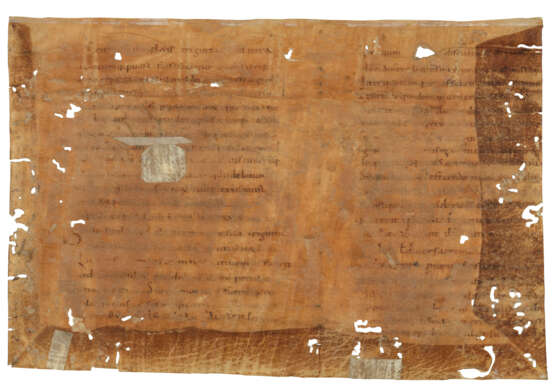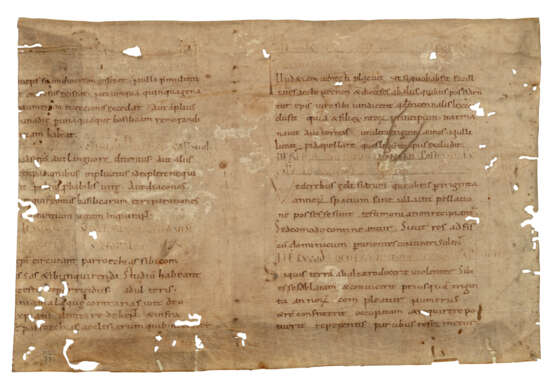ID 869401
Lot 8 | Regino of Prüm (d.915)
Estimate value
£ 3 000 – 5 000
Two partial bifolia from De Synodalibus Causis et Disciplinis Ecclesiasticis, manuscript on vellum [Germany, 10th century].
A contemporary Carolingian witness to the Benedictine historiographer Regino of Prüm’s work on ecclesiastical discipline.
The two bifolia c.206 x 308mm and 186×308mm. 21 lines in a Caroline minuscule, the script with upright and uncial ‘d’ both used, open bowl on ‘g’, majuscule ‘N’ in medial and initial position, 2-shaped ‘r’ and round ‘s’, ascender of ‘t’ rising above crossbar, dotted Caroline ‘y’, tall ascenders, stylized ligatures ‘ct/st’ and final ‘NT’; with faded rubrics in rustic capitals, the text comprising part of Regino of Prüm’s De Synodalibus Causis et Disciplinis Ecclesiasticis, Book 1, Chapters 7-22 (‘pr[i]mum discuciant clericos […] e[i]us d[ominu]s [reci]pi[at]’) (outer faces of both bifolia with text faded or entirely removed by adhesive, bifolia cropped along outer edge with text lacking, rubrics faded, holes in vellum throughout, remains of adhesive).
Provenance:
(1) Philip Bliss (1787–1857), Under-Librarian of the Bodleian Library from 1822-1828, Registrar of Oxford University from 1824-1853, Keeper of the University Archives from 1826-1857 and Principal of St Mary Hall from 1848-1857. His collection of leaves was sold at Sotheby’s, 21 August 1858, lots 100 and 119, where acquired by:
(2) Sir Thomas Phillipps (1792–1872), English antiquary and book collector who amassed the largest collection of manuscript material in the 19th century. Bliss’s collection of leaves became at least partially MS 18133 in the Phillipps library. Sold at Sotheby’s, 24 April 1911, lot 390, where acquired by:
(3) Edmund Hunt Dring (1863–1928), the first managing director of Bernard Quaritch Ltd.
(4) Edmund Maxwell 'Ted' Dring (1906–1990), senior director of Bernard Quaritch.
(5) Bernard Quaritch, Catalogue 1036: Medieval Manuscript Leaves, Principally from a Collection Formed in the 19th Century: Bookhands of the Middle Ages [I] (London, 1984), no. 129.
(6) Colker MS 381; acquired in 1987-88 from Quaritch.
Regino, abbot of Prüm and later of St Martin’s at Trier, was a Benedictine monk and author of one of the essential sources of Carolingian history, the Chronicon. The present bifolia are from his collection of canons drawn up at the request of his friend and patron Radbod, Archbishop of Trier (d. 915) and dedicated to Hatto I, Archbishop of Mainz.
| Genre: | Religious genre |
|---|---|
| Place of origin: | Germany |
| Auction house category: | Medieval & renaissance manuscripts |
| Genre: | Religious genre |
|---|---|
| Place of origin: | Germany |
| Auction house category: | Medieval & renaissance manuscripts |
| Address of auction |
CHRISTIE'S 8 King Street, St. James's SW1Y 6QT London United Kingdom | |
|---|---|---|
| Preview |
| |
| Phone | +44 (0)20 7839 9060 | |
| Buyer Premium | see on Website | |
| Conditions of purchase | Conditions of purchase |





